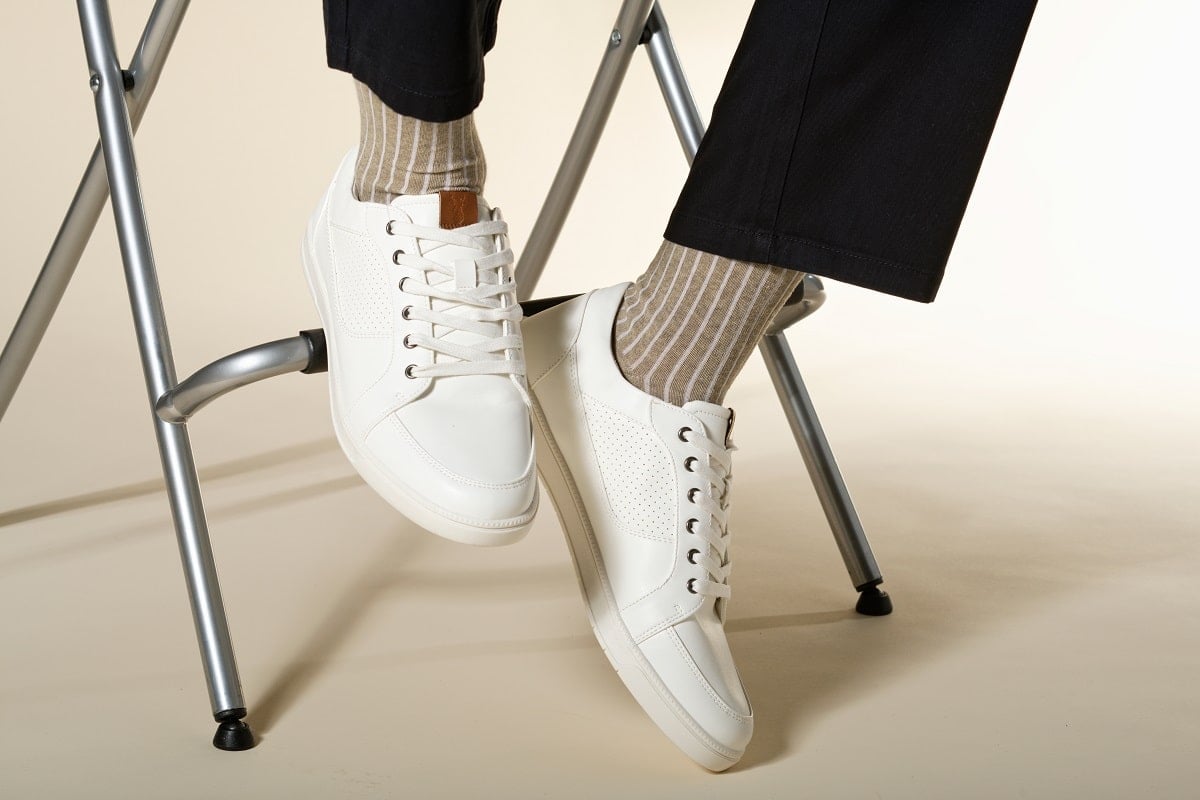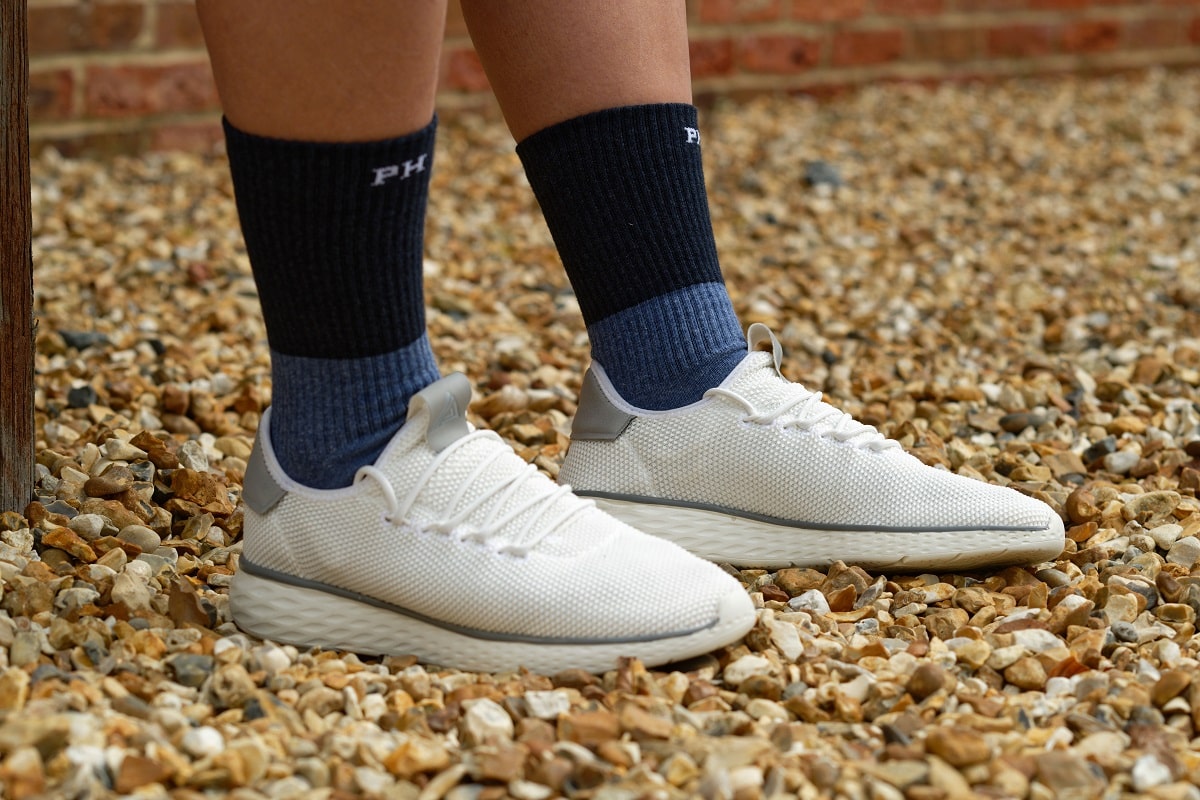1
HOME > New Collections >
PEPER HAROW INTRODUCES A SUSTAINABLE SOCK COLLECTION
Written by Ivan Yaskey in New Collections on the 5th May 2022

As much as we revere heritage construction for its quality and story, design and materials have changed with the times. Over the past few decades, that’s been toward mass produced and flimsier, although as of recent, brands have started considering sustainability more seriously. For luxury sock brand Peper Harow, this push has resulted in a collection made of recycled plastic and repurposed cotton introduced this year. This direction goes beyond the socks themselves to manufacturing operations refined to reduce energy consumption.
About Peper Harow
Despite what’s easily described as a heritage approach to sock making, Peper Harow started in 2013. The name references an area of Surrey dating back to 1727 that’s known for its cricket games. Beyond this nod, craftmanship has remained a priority since the beginning. Men’s and women’s socks are made in West Sussex, UK with fine-gauge needle-knitting machines, high-quality cotton and dyes, and a five-stage quality-control process. This approach results in a longer-lasting, softer pair and a wide range of colours. At the same time, the design goes a step further with a seamless toe intended to lessen friction and ultimately extend a pair’s wear. Peper Harow’s further venture toward full sustainability started last year – not just to reduce their own carbon footprint but to prove that clothing companies in general can make stronger strides toward this goal. Supported by a now completed Kickstarter campaign, product design began in August 2021, and the concept was fully realised by October. A month later, the company tested some samples before officially launching the line at the beginning of 2022.

Construction of Peper Harow Sustainable Socks
Generally speaking, Peper Harow’s sustainable collection includes two basic socks – casual ribbed and sport – made with up to 80 percent recycled materials and still manufactured in West Sussex. This amount includes 28g recycled cotton scraps leftover from T-shirt construction that would otherwise end up in a landfill – and contribute to the growing amount of textile waste – and recycled plastic bottles that, if not repurposed, may have found their way into a river or the ocean. Between these two styles, the casual ribbed is a crew-height sock constructed with 40-percent post-consumer polyester made from plastic bottles recycled in Europe and 40-percent pre-consumer Global Recycled Standard (GRS) cotton. Design remains true to Peper Harow’s signature features: Each is knit for luxurious, long-lasting wear, includes a seamless toe, and comes in five colours. Sport socks feature a 38-percent pre-consumer GRS recycled cotton and 38-percent post-consumer recycled polyester construction. Along with the seamless toe and a choice of three colours, this sock has been crafted for more active pursuits with breathable mesh for improved circulation, cushioning at the toe and sole, a reinforced heel, and arch support. These aspects absorb impact as you move, enhance comfort, and help control perspiration without relying on moisture-wicking fabric treatments.

Considering a Wider-Scale Impact
Oftentimes, a brand’s sustainable offerings amount to using organic cotton or the occasional recycled materials. Although this effort ends up being slightly better for the environment, it doesn’t take into account the myriad of aspects going into production – mainly, where and how materials get sourced and how the facility operates. As consumers become smarter about sustainable shopping, manufacturing, and supply chains, these aspects speak to a brand’s commitment to sustainability and reflect its broader impact. A lack of transparency ultimately signals greenwashing. Peper Harow’s collection attempts to factor in this rippling effect. The recycled cotton, to start, comes from the waste garment factories primarily located in Bangladesh create producing T-shirts. These clothing scraps add up, and Peper Harow’s process ultimately illustrates one approach for repurposing potential textile waste. Packaging is considered from here. Too often, it seems, we spot brands still using plastic garment bags and mailers. Peper Harow tries to lessen the impact of its packaging: Paper labels for the socks come from a supplier nearby – in fact, within walking distance of the brand’s West Sussex facility. 100-percent FSC recycled paper, plus vegetable-based inks, are used rather than virgin materials. This approach simultaneously cuts down on single-use plastic waste and on carbon emissions involved in shipping materials to package the garments to sell.
Going a step further, Peper Harow has opted to address its production to lessen its carbon footprint, boost the local economy, and help preserve UK manufacturing. Excluding materials sourcing, the socks are knit in the UK, which helps increase the number of job opportunities available, helps retain manufacturing skills, and supports quality craftsmanship while stimulating the local economy. To do this, the company has set up solar panels that reduce its energy consumption by 55,000 kWh per year – roughly 20 percent of its reliance on traditional energy sources and offsetting nearly 30 tons of CO2 in the process. The now successfully funded Kickstarter campaign calls attention to the changes Peper Harow is making and what holistically goes into producing this collection. Learn more about this slow fashion approach that ultimately serves as a model for other brands looking to become more sustainable through product, materials, and operations. The recycled cotton socks are available for purchase via the above link as well.

Trending
2
3
4
5
6
7
8
9
10










